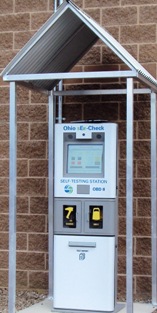
ZKTEK provides all kinds of custom OEM/ODM ATM machine,interactive kiosk,information kiosk, touchscreen kiosk, touchscreen monitor, touchscreen computer, box ipc,digital sginages, pos and metal keyboard products
News: How Self-Service Kiosks Are Changing Customer Behavior
-
 How Self-Service Kiosks Are Changing Customer Behavior Brief:
How Self-Service Kiosks Are Changing Customer Behavior Brief:How Self-Service Kiosks Are Changing Customer Behavior

Soon, you may be able to walk into a McDonalds, tap your order on a “Create Your Taste” touch screen, and receive a burger adjusted to your specifications. Avocado and shaved parmesan on your sandwich? No problem.
McDonalds isn’t the first fast food chain to consider giving customers more control over their orders using technology (though there’s a fair amount of debate about whether customization is really the best way forward for the struggling company). Many of its competitors have been experimenting with self-service apps and kiosks, finding that when customers use them, they tend to spend more money. Taco Bell recently announced that orders made via their new digital app are 20% pricier than those taken by human cashiers, largely because people select additional ingredients. Chili’s, after installing self-service tablets, reported a similar increase in dessert orders. Cinemark theater’s new self-service kiosks have “had concession spending per person climb for 32 straight quarters.”
So why the uptick? I talked with Ryan Buell, an assistant professor at the Harvard Business School, who studies the intersection of operations and customer behavior. It turns out that self-service technologies can pretty dramatically change what people do and how they act – though the research is hardly clear-cut on it being the best option for all businesses. An edited version of our conversation is below.
HBR: What’s going on here? Why are these in-store apps boosting sales?
Buell: There’s actually been some research on this, and some pretty cool examples have emerged.
To start, four researchers at the Rotman School of Management, Duke’s Fuqua School of Business, and the National University of Singapore did a study where they found that, when a liquor store changed from face-to-face to self-service, the market share of difficult-to-pronounce items increased 8.4%. The researchers concluded that consumers might fear being misunderstood or appearing unsophisticated in front of the clerks. Changing to self-service removed the social friction.
Another interesting example they looked into was a pizza chain that introduced online ordering. The customers who were ordering online ordered food with 3% more calories, and also gave 14% more [special] instructions compared with the average purchase over the phone. They concluded that customers’ desire to avoid negative judgment of their eating habits drove the change.
You mentioned McDonald’s. They’ve been experimenting with kiosks for a while. At one store, 10 or so years ago, they found that the average check size was a dollar higher — a 30% increase at the time. And they found that 20% of customers who didn’t initially order a drink would buy one when it was offered. Kiosks, of course, never forget to upsell.
In addition to all of this, there is some research from 2011 showing that a seven second reduction in service times in fast food restaurants can increase the company’s market share by 1% to 3%.
It seems like sort of a win-win, both for companies that want to make more money and for customers who feel more comfortable without that social friction. But are there any downsides?
Yes, there are a bunch of downsides.
Dennis Campbell, Frances Frei, and I have done some research looking at self-service technologies, in banks in particular. Customers’ overall satisfaction with the bank fell as the proportion of their total interactions shifted away from face-to-face channels and toward using ATMs.
I take great pleasure in visiting my local bank branch for quarters every weekend, but I’m not even sure I know why.I think one reason could be that automation sometimes obscures the work that’s being done for us. When we’re interacting with a person, we can see what’s being done to create value for us.
A lot of the technologies are designed to basically obscure that work from customers. In order to make them feel comfortable using an automated technology, we try to make it look as easy and fast and seamless as possible. And in doing that, we strip away the customer’s view of the effort that is going on behind the scenes. When customers aren’t able to see that effort, they appreciate the service that’s being delivered less, and they value the service less as a consequence.
Some self-service technologies are able to buck this trend. Kayak.com is a good example. While it’s searching for flights, it shows you the work that it’s doing behind the scenes to find you the perfect itinerary. After you enter your preferred travel details and click submit, you see the different websites that it’s searching and a running tally of the best rates found so far. Michael Norton and I found that when a website, like Kayak, shows a customer the work it is engaging in on their behalf, customers mind waiting for the service less, and they value the service more.
What factors should companies weigh when they’re thinking about introducing this sort of self-service?
When companies take employees out of the equation, they’re essentially expecting the customer to take on a greater share of the work. And so the design of the technology matters a lot. Some self-service technologies can be delightful to use and others can be very challenging.
An example of one that’s often challenging is the self-service checkout. Stores are essentially asking customers who weren’t trained to do this work to take on the task. But then they added a bunch of sensors and fraud detection mechanisms that make the job more difficult than it would have been for an employee in the first place.
Essentially, there are three things that we think determines when a customer will willingly engage in self-service. First, customers have to know what’s expected of them. Second, they have to be capable of doing what’s expected of them. Finally, and this is one where a lot of companies fall off the rails, they have to see the value of expending the extra effort in order for it to be something that they would willingly engage in.
In the end, what are the things that humans can just do better than apps or kiosks?
Technology lacks flexibility. When we’re interacting with a person and we’re having trouble understanding something, the person can adjust to us. If we’re having a misunderstanding, they can help clarify it. Technology really can’t do either of these things.
A person has the ability to delight us or disappoint us. It’s really hard for a technology to ever delight, however, because it’s standardized and is built on a set of rules. But it is possible for technologies to disappoint us.
If you think about an ATM, it seems like it’s out of order one out of every 10 times you visit it. But it’s not that case that one out of every 10 interactions you have with the ATM machine delights you.
Are there cases where companies can actually lose money with self-service?
There’s an assumption that it’s cheaper to serve a customer through a self-service technology. But that’s not always true.Dennis Campbell and Frances Frei did some research a number of years ago, looking at banks that introduced online banking. And they found this really interesting pattern, which was that when a customer would switch over to online banking, they began to reduce their use of a more costly self-service channel. They were less likely to use the ATM machine. Great, right? They were also less likely to call in and use automated response, too, which is marginally more expensive than online banking.
But here’s the kicker: They also began increasing their use of more costly delivery channels. They came into the branch more, and they started using the call center more, which was actually more expensive. So the tradeoff wasn’t a favorable one.
Piling on top of all of this was an overall increase in transaction volume. And so the net effect of this on a per customer basis was that it actually cost more money to serve the customer.
Do you think the service industry is headed in a much more automated direction in general?
I honestly don’t. Automation will play an important role in interactions that can afford to be transactional rather than relational — especially for interactions optimized around speed and efficiency.
But we’re deeply social animals. And there’s lots and lots of behavioral research that shows that social connections are important to our wellbeing and our mental health, that when we talk to people, we’re happier.
If you think about the places where we’re truly loyal, these are often places where we’ve had the opportunity to develop a relationship, right? So when you walk into a Starbucks you frequent, the baristas will know you by name and they’ll know what drink you want. You feel important. You feel special. Their job is more meaningful because they get to interact with you. Your transaction is more meaningful, because you get to interact with them.


